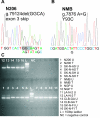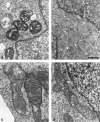No evidence for involvement of SDHD in neuroblastoma pathogenesis
- PMID: 15331017
- PMCID: PMC517501
- DOI: 10.1186/1471-2407-4-55
No evidence for involvement of SDHD in neuroblastoma pathogenesis
Abstract
Background: Deletions in the long arm of chromosome 11 are observed in a subgroup of advanced stage neuroblastomas with poor outcome. The deleted region harbours the tumour suppressor gene SDHD that is frequently mutated in paraganglioma and pheochromocytoma, which are, like neuroblastoma, tumours originating from the neural crest. In this study, we sought for evidence for involvement of SDHD in neuroblastoma.
Methods: SDHD was investigated on the genome, transcriptome and proteome level using mutation screening, methylation specific PCR, real-time quantitative PCR based homozygous deletion screening and mRNA expression profiling, immunoblotting, functional protein analysis and ultrastructural imaging of the mitochondria.
Results: Analysis at the genomic level of 67 tumour samples and 37 cell lines revealed at least 2 bona-fide mutations in cell lines without allelic loss at 11q23: a 4bp-deletion causing skip of exon 3 resulting in a premature stop codon in cell line N206, and a Y93C mutation in cell line NMB located in a region affected by germline SDHD mutations causing hereditary paraganglioma. No evidence for hypermethylation of the SDHD promotor region was observed, nor could we detect homozygous deletions. Interestingly, SDHD mRNA expression was significantly reduced in SDHD mutated cell lines and cell lines with 11q allelic loss as compared to both cell lines without 11q allelic loss and normal foetal neuroblast cells. However, protein analyses and assessment of mitochondrial morphology presently do not provide clues as to the possible effect of reduced SDHD expression on the neuroblastoma tumour phenotype.
Conclusions: Our study provides no indications for 2-hit involvement of SDHD in the pathogenesis of neuroblastoma. Also, although a haplo-insufficient mechanism for SDHD involvement in advanced stage neuroblastoma could be considered, the present data do not provide consistent evidence for this hypothesis.
Figures



Similar articles
-
CADM1 is a strong neuroblastoma candidate gene that maps within a 3.72 Mb critical region of loss on 11q23.BMC Cancer. 2008 Jun 17;8:173. doi: 10.1186/1471-2407-8-173. BMC Cancer. 2008. PMID: 18559103 Free PMC article.
-
Molecular characterization of novel germline deletions affecting SDHD and SDHC in pheochromocytoma and paraganglioma patients.Endocr Relat Cancer. 2009 Sep;16(3):929-37. doi: 10.1677/ERC-09-0084. Epub 2009 Jun 22. Endocr Relat Cancer. 2009. PMID: 19546167
-
RASSF1A promoter region CpG island hypermethylation in phaeochromocytomas and neuroblastoma tumours.Oncogene. 2001 Nov 8;20(51):7573-7. doi: 10.1038/sj.onc.1204968. Oncogene. 2001. PMID: 11709729
-
Oligonucleotide microarray analysis of gene expression in neuroblastoma displaying loss of chromosome 11q.Carcinogenesis. 2004 Sep;25(9):1599-609. doi: 10.1093/carcin/bgh173. Epub 2004 Apr 16. Carcinogenesis. 2004. PMID: 15090470 Review.
-
Mutations of the SDHB and SDHD genes.Fam Cancer. 2005;4(1):49-54. doi: 10.1007/s10689-004-4227-4. Fam Cancer. 2005. PMID: 15883710 Review.
Cited by
-
No evidence for promoter region methylation of the succinate dehydrogenase and fumarate hydratase tumour suppressor genes in breast cancer.BMC Res Notes. 2009 Sep 25;2:194. doi: 10.1186/1756-0500-2-194. BMC Res Notes. 2009. PMID: 19778456 Free PMC article.
-
Energy metabolism in neuroblastoma and Wilms tumor.Transl Pediatr. 2015 Jan;4(1):20-32. doi: 10.3978/j.issn.2224-4336.2015.01.04. Transl Pediatr. 2015. PMID: 26835356 Free PMC article. Review.
-
Low aerobic mitochondrial energy metabolism in poorly- or undifferentiated neuroblastoma.BMC Cancer. 2010 Apr 19;10:149. doi: 10.1186/1471-2407-10-149. BMC Cancer. 2010. PMID: 20398431 Free PMC article.
-
SDH mutations in tumorigenesis and inherited endocrine tumours: lesson from the phaeochromocytoma-paraganglioma syndromes.J Intern Med. 2009 Jul;266(1):19-42. doi: 10.1111/j.1365-2796.2009.02111.x. J Intern Med. 2009. PMID: 19522823 Free PMC article. Review.
-
Inhibition of Neuroblastoma Tumor Growth by Ketogenic Diet and/or Calorie Restriction in a CD1-Nu Mouse Model.PLoS One. 2015 Jun 8;10(6):e0129802. doi: 10.1371/journal.pone.0129802. eCollection 2015. PLoS One. 2015. PMID: 26053068 Free PMC article.
References
-
- Cooper MJ, Hutchins GM, Cohen PS, Helman LJ, Mennie RJ, Israel MA. Human neuroblastoma tumor cell lines correspond to the arrested differentiation of chromaffin adrenal medullary neuroblasts. Cell Growth Differ. 1990;1:149–59. - PubMed
-
- Maris JM, Matthay KK. Molecular biology of neuroblastoma. J Clin Oncol. 1999;17:2264–79. - PubMed
-
- Plantaz D, Vandesompele J, Van Roy N, Lastowska M, Bown N, Combaret V, Favrot MC, Delattre O, Michon J, Benard J, et al. Comparative genomic hybridization (CGH) analysis of stage 4 neuroblastoma reveals high frequency of 11q deletion in tumors lacking MYCN amplification. Int J Cancer. 2001;91:680–6. doi: 10.1002/1097-0215(200002)9999:9999<::AID-IJC1114>3.0.CO;2-R. - DOI - PubMed
Publication types
MeSH terms
Substances
LinkOut - more resources
Full Text Sources
Medical

